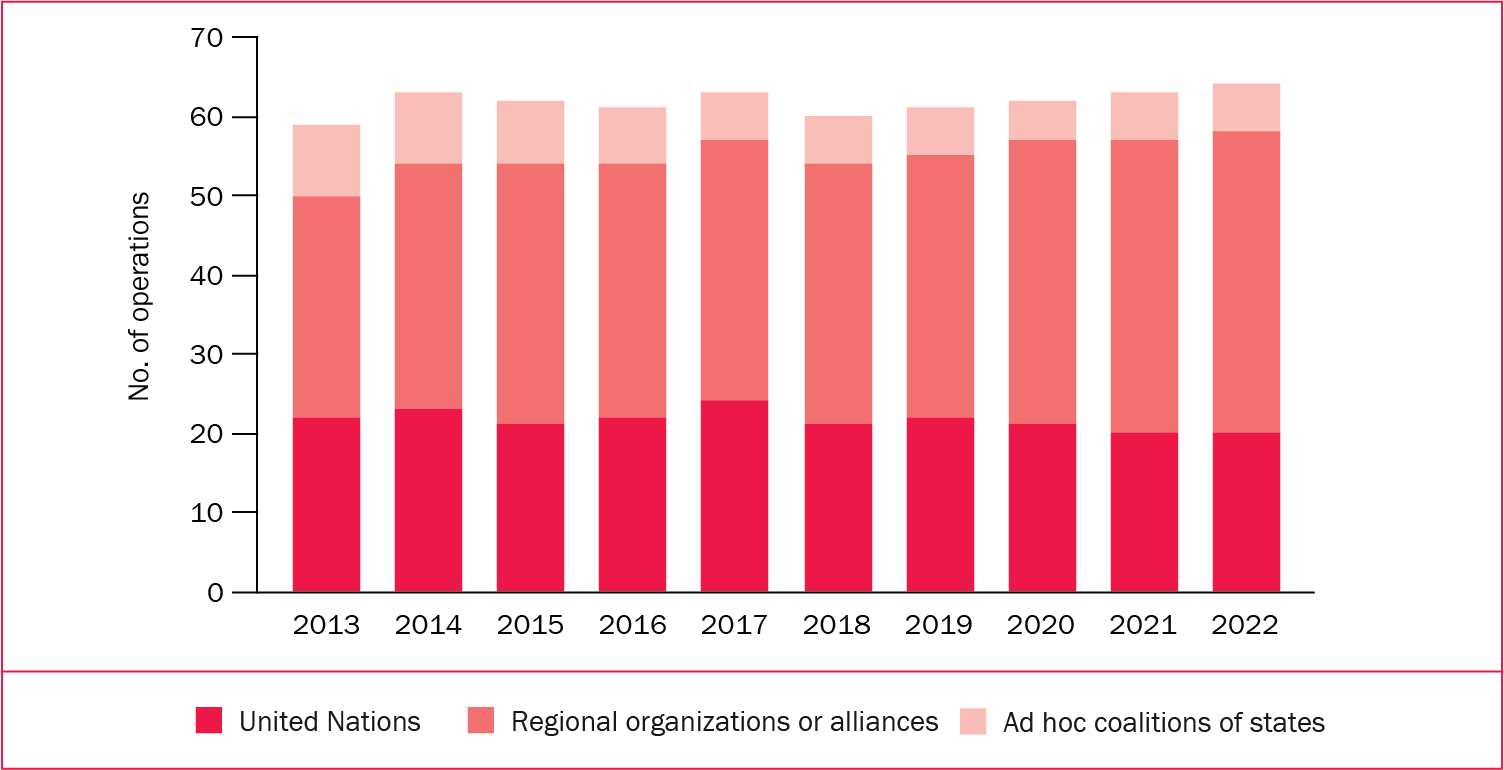3. Multilateral peace operations
Overview, Claudia Pfeifer Cruz and Timo Smit
I. Global trends and developments in peace operations, Claudia Pfeifer Cruz and Timo Smit
II. Organizations conducting multilateral peace operations, Claudia Pfeifer Cruz and Timo Smit
III. The way forward for multilateral peace operations, Claudia Pfeifer Cruz
IV. Table of multilateral peace operations, 2022, Claudia Pfeifer Cruz
There were 64 active multilateral peace operations in 2022—an increase of one compared with the previous year. Five started in 2022: the Collective Security Treaty Organization (CSTO) Collective Peace-keeping Forces to Kazakhstan;
the African Union Transition Mission in Somalia (ATMIS); the Economic Community of West African States Stabilisation Support Mission in Guinea-Bissau (SSMGB); the East African Community Regional Force in the Democratic Republic of the Congo (EACRF-DRC) and the African Union Monitoring, Verification and Compliance Mission in Ethiopia (AU-MVCM). Four ended in 2022: the CSTO Collective Peacekeeping Forces to Kazakhstan; the Organization for Security and Co-operation in Europe (OSCE) Special Monitoring Mission to Ukraine (SMM); the African Union Mission in Somalia (AMISOM); and the International Monitoring Team (IMT) in Mindanao.
The number of personnel deployed to multilateral peace operations globally increased in 2022, breaking a trend of declining personnel numbers between 2016 and 2021. The rise in 2022 mostly reflected variations in personnel deployments to operations in sub-Saharan Africa, which continued to host the most peace operations and personnel. Four of the five new operations in 2022 were launched in the region and all of them by regional organizations. These newly established missions illustrate the increasing regionalization of peace operations and the emphasis on the deployment of uniformed rather than civilian personnel.
Number of multilateral peace operations, by type of conducting organization, 2013–22

Fatalities in UN peace operations
During 2022, 74 international personnel (53 military, 13 civilian and 8 police) and 27 local staff died while serving in United Nations peace operations, 21 fewer than in 2021. Even though the total number of fatalities in 2022 decreased, the number of hostile deaths—fatalities caused by malicious acts—increased from 24 in 2021 to 32 in 2022. The UN Multidimensional Integrated Stabilization Mission in Mali (MINUSMA) continued to be the deadliest mission for peacekeepers in 2022, with 25 fatalities registered, 10 fewer than in 2021. The deadliest event in the year occurred in March, when a helicopter assigned to the UN Organization Stabilization Mission in the Democratic Republic of the Congo (MONUSCO) crashed killing eight UN peacekeepers.
Eroding relations with host governments and growing geopolitical rivalries
The challenging relations between peace operations and host governments reached a new low in 2022, with the expulsion of UN personnel from the Democratic Republic of the Congo and Mali. The erosion of these relations was intensified by demonstrations in which protestors demanded the closure of UN peacekeeping operations in both countries given their alleged ineffectiveness. In Mali and the Central African Republic, these difficult relationships were further complicated by the presence of the Wagner Group, a Russian private military and security company, which was accused of participating in human rights abuses and disinformation campaigns. Finally, the war in Ukraine exacerbated already mounting geo-political rivalries, particularly between Western countries and Russia. This influenced the closure of the OSCE SMM, as well as difficult political dynamics within the UN Security Council.